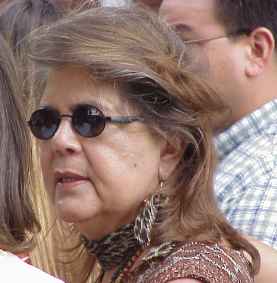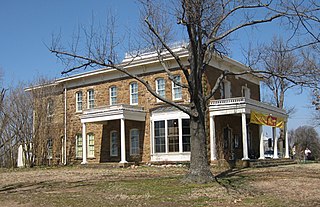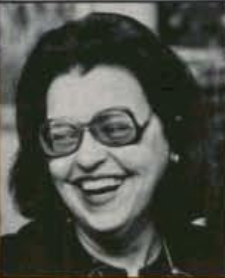Related Research Articles

Wilma Pearl Mankiller was a Native American activist, social worker, community developer and the first woman elected to serve as Principal Chief of the Cherokee Nation. Born in Tahlequah, Oklahoma, she lived on her family's allotment in Adair County, Oklahoma, until the age of 11, when her family relocated to San Francisco as part of a federal government program to urbanize Indigenous Americans. After high school, she married a well-to-do Ecuadorian and raised two daughters. Inspired by the social and political movements of the 1960s, Mankiller became involved in the Occupation of Alcatraz and later participated in the land and compensation struggles with the Pit River Tribe. For five years in the early 1970s, she was employed as a social worker, focusing mainly on children's issues.

The Five Civilized Tribes Museum in Muskogee, Oklahoma, showcases the art, history, and culture of the so-called "Five Civilized Tribes": the Cherokee, Chickasaw, Choctaw, Muscogee (Creek), and Seminole tribes. Housed in the historic Union Indian Agency building, the museum opened in 1966.

Bacone College, formerly Bacone Indian University, is a private college in Muskogee, Oklahoma. Founded in 1880 as the Indian University by missionary Almon C. Bacone, it was originally affiliated with the mission arm of what is now American Baptist Churches USA. Renamed as Bacone College in the early 20th century, it is the oldest continuously operated institution of higher education in Oklahoma. The liberal arts college has had strong historic ties to several tribal nations, including the Muscogee and Cherokee. The Bacone College Historic District has been on the National Register of Historic Places listings in Muskogee County, Oklahoma since 2014.

Joan Hill, also known as Che-se-quah, was a Muscogee Creek artist of Cherokee ancestry. She was one of the most awarded Native American women artists in the 20th century.
Talmadge Davis (1962–2005) was a Cherokee artist, who explored historical and military themes in his highly naturalistic paintings.
Barbara McAlister is a mezzo-soprano Native American opera singer from Muskogee, Oklahoma.
Cecil Dick, or Degadoga (1915–1992) was a well-known Cherokee artist often referred to as "the Father of Cherokee Traditional Art".
The Bacone school or Bacone style of painting, drawing, and printmaking is a Native American intertribal "Flatstyle" art movement, primarily from the mid-20th century in Eastern Oklahoma and named for Bacone College. This art movement bridges historical, tribally-specific pictorial painting and carving practices towards an intertribal Modernist style of easel painting. This style is also influenced by the art programs of Chilocco Indian School, north of Ponca City, Oklahoma, and Haskell Indian Industrial Training Institute, in Lawrence, Kansas and features a mix of Southeastern, Prairie, and Central Plains tribes.
Sharon Irla is a Cherokee artist, enrolled in the Cherokee Nation. A self-taught artist, Irla began entering competitive art shows in 2003. Her collective body of works span the fields of painting, murals, graphics, photography, and custom picture frames with Southeastern Woodlands / Mississippian motifs. The majority of her awarded works are oil-on-canvas portraits of Cherokee women in both contemporary and historical settings.
Dana Tiger is a Muscogee artist of Seminole and Cherokee descent from Oklahoma. Her artwork focuses on portrayals of strong women. She uses art as a medium for activism and raising awareness. Tiger was inducted into the Oklahoma Women's Hall of Fame in 2001.
David Emmett Williams was a Native American painter, who was Kiowa/Tonkawa/Kiowa-Apache from Oklahoma. He studied with Dick West at Bacone College and won numerous national awards for his paintings. He painted in the Flatstyle technique that was taught at Bacone from the 1940s to the 1970s.

Jennie Ross Cobb is the first known Native American woman photographer in the United States. She began taking pictures of her Cherokee community in the late 19th century. The Oklahoma Historical Society used her photos of the Murrell Home to restore that building, which is now a museum. Trained as a teacher, Cobb worked as a florist in Texas before returning to Oklahoma to spearhead the restoration of the Murrell Home.

Sandy Fife Wilson is a Muscogee (Creek) art educator, fashion designer and artist. After graduating from the Institute of American Indian Arts and Northeastern Oklahoma State University, she became an art teacher, first working in the public schools of Dewey, Oklahoma. When Josephine Wapp retired as the textile instructor at the Institute of American Indian Arts, Wilson was hired to teach the design courses. After three years, in 1979, she returned to Oklahoma and taught at Chilocco Indian School until it closed and then worked in the Morris Public School system until her retirement in 2009.
Jimmie Carole Fife Stewart is a Muscogee (Creek) art educator, fashion designer, and artist. After graduating from the Chilocco Indian School and taking courses at the University of Arizona, she earned a degree from Oklahoma State University and began working as a teacher. After a six-year stint working for Fine Arts Diversified, she returned to teaching in 1979 in Washington, Oklahoma. Primarily known as a painter, using watercolor or acrylic media, Fife-Stewart has also been involved in fashion design. Her works have been shown mostly in the southwestern United States and have toured South America. Having won numerous awards for her artworks, she was designated as a Master Artist by the Five Civilized Tribes Museum in 1997.

Valjean McCarty Hessing was a Choctaw painter, who worked in the Bacone flatstyle. Throughout her career, she won 9- awards for her work and was designated a Master Artist by the Five Civilized Tribes Museum in 1976. Her artworks are in collections of the Heard Museum of Phoenix, Arizona; the Philbrook Museum of Art in Tulsa, Oklahoma; the Southern Plains Indian Museum in Anadarko, Oklahoma; and the Wheelwright Museum of the American Indian of Santa Fe, New Mexico, among others.
Jeanne Rorex-Bridges is painter and illustrator based in Oklahoma. She is a member of the Echota Cherokee Tribe of Alabama, a state-recognized tribe.

Jane McCarty Mauldin was a Choctaw artist, who simultaneously worked in commercial and fine art exhibiting from 1963 through 1997. Over the course of her career, she won more than 100 awards for her works and was designated as a "Master Artist" by the Five Civilized Tribes Museum in Muskogee, Oklahoma. She has works in the permanent collections of the Heard Museum, the Heritage Center of the Red Cloud Indian School and the collections of the Department of the Interior, as well as various private collections.

Anna Mitchell was a Cherokee Nation potter who revived the historic art of Southeastern Woodlands pottery for Cherokee people in Oklahoma. Her tribe designated her as a Cherokee National Treasure and has works in numerous museum collections including the Smithsonian National Museum of the American Indian, the Museum of Fine Arts, Boston, and the Fred Jones Jr. Museum of Art, among others.
Joan Brown is an American artist, illustrator and educator. She is of Cherokee and Creek descent from Oklahoma. Her work is of the Bacone school style.

Atalie Unkalunt was a Cherokee singer, interior designer, activist, and writer. Her English name Iva J. Rider appears on the final rolls of the Cherokee Nation. Born in Indian Territory, she attended government-run Indian schools and then graduated from high school in Muskogee, Oklahoma. She furthered her education at the New England Conservatory of Music in Boston, Massachusetts. After a thirteen-month engagement with the YMCA as a stenographer and entertainer for World War I troops in France, she returned to the United States in 1919 and continued her music studies. By 1921, she was living in New York City and performing a mixture of operatic arias, contemporary songs, and Native music. Her attempts to become an opera performer were not successful. She was more accepted as a so-called "Indian princess", primarily singing the works of white composers involved in the Indianist movement.
References
Citations
- 1 2 3 4 "Mary Adair". Native American Artists Resource Collection Online. Heard Museum Billie Jane Baguley Library and Archives. Retrieved March 3, 2022.
- ↑ Graham, Roger (November 13, 2015). "Murrow Indian Children's Home renovates cottages". Cherokee Phoenix. Retrieved March 3, 2022.
- 1 2 3 4 5 Anderson & Verble 1980, p. 76.
- 1 2 3 4 5 Broder 2013, p. 265.
- 1 2 3 4 The Stilwell Democrat-Journal 1958, p. 5.
- ↑ Hewitson 2010, pp. 277–278.
- 1 2 3 4 5 6 7 Campbell 1993, p. 39.
- ↑ Hewitson 2010, p. 278.
- 1 2 Chavez 2015.
- ↑ The Stilwell Democrat-Journal 1959, p. 4.
- ↑ The Stilwell Democrat-Journal 1962, p. 4.
- ↑ First American Art Magazine 2017.
- ↑ The Daily Ardmoreite 1972, p. 4.
- ↑ The Daily Oklahoman 1972, p. 11.
- ↑ The Indian Journal 1973, p. 17.
- ↑ The Daily Oklahoman 1976, p. 16.
- ↑ The Daily Oklahoman 1977, p. 202.
- ↑ Carter 1985, p. 4.
- ↑ Price 1985.
- ↑ The Daily Oklahoman 1987, p. 98.
- ↑ Edmon Low Library 2011.
- ↑ Anadisgoi Magazine 2015, p. 10.
- ↑ Spaulding 2019.
- ↑ Johnson 1972, p. 42.
- ↑ "Native American gardening: Stories, projects, and recipes for families". WorldCat. Retrieved November 26, 2023.
Bibliography
- Anderson, Owanah P.; Verble, Sedelta D. (1980). Resource Guide of American Indian and Alaska Native Women (Report). Wichita Falls, Texas: National Women's Program Development, Inc.
- Broder, Patricia Janis (2013). Earth Songs, Moon Dreams: Paintings by American Indian Women. New York, New York: St. Martin's Press. ISBN 978-1-4668-5972-2.
- Campbell, David (1993). Native American Art and Folklore: A Cultural Celebration. New York, New York: Crescent Books. ISBN 0-517-06975-X.
- Carter, Sue (July–August 1985). "Today in Oklahoma". Oklahoma Today . Vol. 35, no. 4. Oklahoma City, Oklahoma: Oklahoma Department of Tourism and Recreation. p. 4. ISSN 0030-1892 . Retrieved August 4, 2019.
- Chavez, Will (March 27, 2015). "HorseChief creates art based on Cherokee history, culture". The Cherokee Phoenix . Tahlequah, Oklahoma. Archived from the original on August 8, 2019. Retrieved August 9, 2019.
- Hewitson, Jim (2010). Tam Blake & Co.: The Story of the Scots in America. London, England: OTCEditions. ISBN 978-1-84986-005-5.
- Johnson, C. W. (January 23, 1972). "Without Reservations". The Springfield Leader . Springfield, Missouri. p. 42. Retrieved August 8, 2019– via Newspapers.com.
- Price, Mary Sue (February 24, 1985). "Artists Dip Deeply Into Heritage". The Daily Oklahoman . Oklahoma City, Oklahoma. Archived from the original on August 4, 2019. Retrieved August 4, 2019.
- Spaulding, Cathy (May 8, 2019). "Women the focus of art exhibit". The Muskogee Phoenix . Muskogee, Oklahoma. Archived from the original on August 3, 2019. Retrieved August 4, 2019.
- "Cherokee Homecoming Art Show, 2017". First American Art Magazine. Norman, Oklahoma. August 26, 2017. Archived from the original on August 8, 2019. Retrieved August 9, 2019.
- "Goddard Pair Has Indian Art". The Daily Ardmoreite . Ardmore, Oklahoma. May 31, 1972. p. 4. Retrieved August 8, 2019– via Newspaperarchive.com.
- "Improving access to health". Anadisgoi Magazine. Tahlequah, Oklahoma: Cherokee Nation. Winter 2015. p. 10. Retrieved August 9, 2019.
- "Indian Art Judged". The Oklahoman . Oklahoma City, Oklahoma. October 23, 1977. p. 202. Retrieved August 9, 2019– via Newspapers.com.
- "Indian Arts at OU". The Oklahoman . Oklahoma City, Oklahoma. October 21, 1972. p. 11. Retrieved August 9, 2019– via Newspapers.com.
- "Indian Arts for Women Are Planned". The Oklahoman . Oklahoma City, Oklahoma. October 22, 1976. p. 16. Retrieved August 9, 2019– via Newspapers.com.
- "Indian Women Art Exhibit to Open Today". The Oklahoman . Oklahoma City, Oklahoma. December 6, 1987. p. 98. Retrieved August 9, 2019– via Newspapers.com.
- "Mary Adair Becomes Bride in Arizona". The Stilwell Democrat-Journal. Stilwell, Oklahoma. June 12, 1958. p. 5. Retrieved August 8, 2019– via Newspapers.com.
- "New Arrivals". The Stilwell Democrat-Journal. Stilwell, Oklahoma. September 10, 1959. p. 4. Retrieved August 9, 2019– via Newspapers.com.
- "Miss MacMillan, John Adair Wed". The Stilwell Democrat-Journal. Stilwell, Oklahoma. June 7, 1962. p. 4. Retrieved August 9, 2019– via Newspapers.com.
- "Oral history interview with Mary Adair". dc.library.okstate.edu. Stillwater, Oklahoma: Edmon Low Library. December 8, 2011. Retrieved August 9, 2019.
- "Sherwood Forest Chit Chat". The Indian Journal . Eufaula, Oklahoma. December 13, 1973. p. 17. Retrieved August 8, 2019– via Newspaperarchive.com.